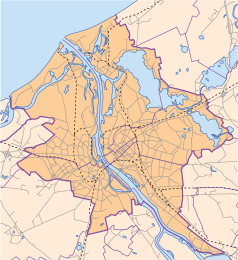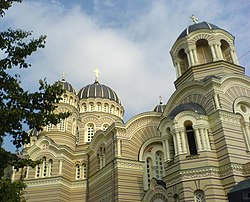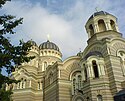Sobór Narodzenia Pańskiego w Rydze
| Ten artykuł od 2009-04 wymaga zweryfikowania podanych informacji. |
| katedra | |||||||||||||||||||||||||
 Katedra w 2006 | |||||||||||||||||||||||||
| Państwo | |||||||||||||||||||||||||
|---|---|---|---|---|---|---|---|---|---|---|---|---|---|---|---|---|---|---|---|---|---|---|---|---|---|
| Miejscowość | |||||||||||||||||||||||||
| Wyznanie | |||||||||||||||||||||||||
| Kościół | |||||||||||||||||||||||||
| Metropolia | |||||||||||||||||||||||||
| Sobór | od 1883 | ||||||||||||||||||||||||
| Wezwanie | |||||||||||||||||||||||||
| Wspomnienie liturgiczne | 25 grudnia/7 stycznia | ||||||||||||||||||||||||
| |||||||||||||||||||||||||
| |||||||||||||||||||||||||
Położenie na mapie Łotwy (c) Karte: NordNordWest, Lizenz: Creative Commons by-sa-3.0 de | |||||||||||||||||||||||||
Sobór Narodzenia Pańskiego[2] (łot. Rīgas Kristus Piedzimšanas pareizticīgo katedrāle) – katedra Łotewskiej Cerkwi Prawosławnej (i eparchii ryskiej) znajdująca się w Rydze, stolicy Łotwy.
Katedra została zbudowana w latach 1876–1883 według projektu Nikołaja Czagina w stylu neobizantyjskim. Katedra ma 40 m wysokości[1].
Powstała z inicjatywy generalnego gubernatora Piotra Bagrationa oraz biskupa Weniamina, a fundusze na budowę przeznaczył car Imperium Rosyjskiego Aleksander II. Podczas I wojny światowej wojska niemieckie przemianowały katedrę na zbór luterański.
W międzywojennej Łotwie w 1921 katedra Narodzenia Pańskiego ponownie wróciła do swojego pierwotnego wyznania. Jedynym problemem były próby wprowadzenia przez władze państwowe języka łotewskiego do liturgii, co się jednak nie udało. W latach 60. XX w. władze Związku Radzieckiego nakazały zamknąć katedrę, w której urządzono planetarium. Świątynia została ponownie otwarta w 1991 po uzyskaniu niezależności Łotwy od ZSRR. Katedra jest obecnie największą cerkwią prawosławną znajdującą się w krajach bałtyckich.
Galeria
- (c) Diego Delso, CC BY-SA 3.0
Ikonostas
Przypisy
- ↑ a b c Opis katedry na Emporis
- ↑ Polski egzonim przyjęty na 120. posiedzeniu KSNG.
Linki zewnętrzne
Media użyte na tej stronie
Blue Shield - the Distinctive emblem for the Protection of Cultural Property. The distinctive emblem is a protective symbol used during armed conflicts. Its use is restricted under international law.
(c) Diego Delso, CC BY-SA 3.0
Cathedral of the Nativity of Christ, Riga, Latvia
Autor: Buchhändler, Licencja: CC BY-SA 4.0
Blick in die Kuppel der Christi-Geburt-Kathedrale, Riga
© Scotch Mist / Wikimedia Commons / CC BY-SA 4.0
Latvia, officially the 'Republic of Latvia', is a country in the Baltic region of Northern Europe. Since its independence, Latvia has been referred to as one of the ‘Baltic states’.
After centuries of Swedish, Polish-Lithuanian and Russian rule, a rule mainly executed by the Baltic German aristocracy, the Republic of Latvia was established on 18 November 1918 when it broke away and declared independence in the aftermath of World War I. However, by the 1930s the country became increasingly autocratic after the coup in 1934 establishing an authoritarian regime under Kārlis Ulmanis. The country's 'de facto' independence was interrupted at the outset of World War II, beginning with Latvia's forced incorporation into the Soviet Union, followed by the invasion and occupation by Nazi Germany in 1941, and the re-occupation by the Soviets in 1944 (Courland Pocket in 1945) to form the Latvian SSR for the next 45 years. The peaceful Singing Revolution, starting in 1987, called for Baltic emancipation from Soviet rule and condemning the Communist regime's illegal takeover. It ended with the Declaration on the Restoration of Independence of the Republic of Latvia on 4 May 1990, and restoring 'de facto' independence on 21 August 1991.
Latvia’s capital and largest city is Riga which was founded in 1201 and is a former Hanseatic League member. Riga's historical centre is a UNESCO World Heritage Site, noted for its Art Nouveau/Jugendstil architecture and nineteenth century wooden buildings.
The Nativity of Christ Cathedral in Riga, was built in a Neo-Byzantine style between 1876 and 1883, during the period when the country was part of the Russian Empire. It is the largest Orthodox cathedral in the Baltic provinces and was built with the blessing of the Russian Tsar Alexander II.
The Scotch Mist Gallery contains many photographs of historic buildings, monuments and memorials of Poland and countries that previously comprised the Polish-Lithuanian Commonwealth.
(c) Karte: NordNordWest, Lizenz: Creative Commons by-sa-3.0 de
Location map of Latvia
Autor: David Jackson, Licencja: CC-BY-SA-3.0
Latvia, Riga Orthodox Cathedral
План Риги
Autor: Buchhändler, Licencja: CC BY-SA 4.0
Blick vom Eingang ins Kircheninnere, Christi-Geburt-Kathedrale, Riga
















